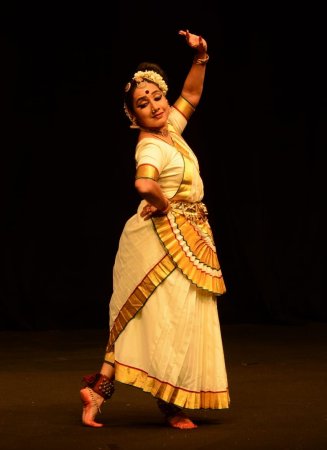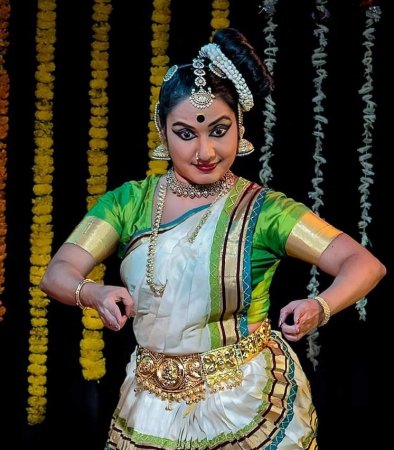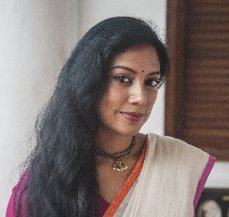
|
 |

|
 |
Reframing Swati Padams: A conversation with Dr. Neena Prasad - Shereen Saif e-mail: shereen.saif@gmail.com May 8, 2024 As the haunting melody in Aahiri weaves a mood of pathos, a lovelorn woman confesses to her beautiful moon-faced friend: "Oh, Madirakshi (one with intoxicating eyes)! Alas! My heart can no longer bear this turmoil caused by Cupid. What am I to do?" In another scenario, set to the tune of Asaveri, a pining heroine seeks out her lover, only to find him aloof. Emboldened by the sway she has over him, she questions, "Oh, Beloved! Why do you not speak to me? What wrong have I done to deserve this?" "Panimathi mukhi bale" and "Enthaho vallabha", two widely performed padams in Mohiniyattam, trace their origin to the early 19th century in Kerala, a time of great creative resurgence in poetry, music and dance. The former composed by Swati Thirunal, the erstwhile ruler of Travancore, and the latter, penned by his celebrated court poet Irayimman Thampi are two classic love ballads of that era, steeped in the ethos of the Vaishnava bhakti movement that had by then gained prominence all over India. Much like Sufi poetry, the lyrical content of these padams is intimate, sensual and carries the passionate longing for an absent beloved. Treated allegorically, the yearning of the heroine is interpreted as the soul's aching and desire for union with the divine. However, even though the intention of the poetry is anchored in the devotional, the dancer's path to evoke rasa lies not in portraying chaste devotion. Rather, the opposite! Through the explicit and aesthetic portrayal of passion. In the hands of a mature performer, a love-soaked padam can inspire a divine, transcendental experience says Mohiniyattam dancer, researcher and choreographer Dr. Neena Prasad. To explore this subject in depth, a 10-day intensive workshop was recently organized exclusively for dancers trained at Sougandhika Centre for Mohiniyattam in Thiruvananthapuram, a kalari she established 20 years ago for research and development of the art form. The workshop curriculum covered Mohiniyattam movement vocabulary, abhinaya techniques, appreciation of Swati Thirunal's poetry and music and her approach to choreographing a padam. Rooted in the past As part of preparing the imagination to tackle padams, the intensive began with a discussion of the historical context and an overview of Swati Thirunal's prolific contribution as a poet and music composer in his short life of 33 years. By the time of his birth in 1813, Carnatic music had matured into its golden age thanks to the contributions of the famed Musical Trinity of Tanjavur - Tyagaraja, Muthuswami Dikshitar, and Syama Sastri. The same city also produced a classical music quartet - four brothers Chinnayya, Ponnayya, Sivanandam and Vadivelu, who hailed from the dance lineage of the Brihadisvara temple. They trained under Muthuswamy Dikshitar and came to be associated with the royal courts of Tanjavur, Mysore and the youngest of the lot, Vadivelu, served in Travancore, under the patronage of Maharaja Swati Thirunal. Together Swati and Vadivelu created Carnatic compositions for vocal rendition and to accompany Bharatanatyam or sadir as it was referred to then. When Swati heard of the Keralite dance form Mohiniyattam that was centred around Thrissur and Palakkad, he requested Manaveda, the Zamorin of Calicut renowned for his authorship of Krishnattam, to send a group of Mohiniyattam dancers to Travancore along with the nattuvanar Shankara Menon.  Neena Prasad "That was the first time Swati saw a Mohiniyattam performance and he was deeply touched by its sensuality and simple beauty that carried the fragrance of Kerala. He realized that the dance form neither had literary support nor patronage to help it flourish so he began to create compositions specifically for Mohiniyattam. With the support of Vadivelu, he also enabled the development of the form and structure of the performance through exchanges between the Telugu sadir and the Malayali dancers", says Dr. Neena who had as part of her Ministry of Culture-funded junior fellowship, spent two years researching Swati Thirunal's contributions to Mohiniyattam. Through his padams, Swati Thirunal also developed a nayika with an "unparalleled capacity to entice appreciative minds, leading them to the realm of maya (illusion)", she adds. After this stylistic highpoint in the form's history between 1829-1847, it plunged into its dark ages after the passing of the monarch. With the loss of royal patronage, it degenerated into a form that came to be looked upon as immoral. However, in the 1930s, it was given a new lease of life as "untainted gold" at Kerala Kalamandalam. As a young dancer, Dr. Neena recalls feeling uninspired learning the Mohiniyattam padams choreographed in the Kalamandalam style. While they were technically sound with all the necessary dance movements, tattimittu, chari and hand gestures to communicate the text, she felt it was devoid of creative thinking and lacking in soul. Today, she attributes it to the fact that it was presented by a "fearful body". To wipe away any stigma associated with the form, the senior practitioners had to "tone down the shringara" and "sanitize" the padams of any elements that could be misconstrued as bold and suggestive. "Back then, the dancers did not have the artistic freedom we enjoy now. The padams had to be covered in a sheath of modesty. They were all brilliant, thinking dancers but because social reality loomed above them like a sword, they were careful about how the padam was choreographed. This unfortunately meant that the padams could not bloom to its full potential," elaborates Dr Neena. It was after watching one of the early pioneers, veteran dancer Bharati Shivaji's interpretation of Poontein nermozhi that everything changed about the way she saw padams. The young Neena was mesmerized by Bharati's involvement with the verse and music, how she translated it into lyrical moments that were simple and touching. Most of all, it was her complete belief in the aesthetics of the native culture and how she used her form to reflect its beauty. "She's not a Malayali yet she created the soulful presence of a native woman in her padam. I'll never forget the spell she cast," Dr. Neena recalls. Today, after decades of her own practice and having trained under greats like Kalamandalam Sugandhi and Kalamandalam Kshemavathy, Dr Neena firmly believes that the ethos of Mohiniyattam is grounded in what she calls "puradanatvam" - loosely translated to mean "ancientness". It carries with it the weight of history and its role is to transport the onlooker to a bygone era of Kerala's cultural decadence through its music, lyrics and form. Slow burn romance Padams in Bharatanatyam are vibrant. They offer a variety in tempo and situations and their strength lie in the technical virtuosity of the dancer. In Mohiniyattam, padams are executed in an unhurried tempo (vilamba kaala). There are no surprising themes and neither are there intricate talam patterns to divert the spectator's attention from the sensuous protagonist. Like a khayal slowly rendered, the music, lyrics, gesticulation pattern and the dance are aimed at touching the spectator deeply and drawing them into the illusionary world of the Mohini. "The dancer becomes a portal for multi-layered expression. Her body will respond to the ragam, she will interpret the content and create a kinesphere that supports her artistic expression. She takes the metaphors in the text and creates moving images through her choreography. Her emotional involvement is palpable and real," says Dr Neena as she explains how the dancer evokes rasa. Separation as an aesthetic experience Vipralambha shringaram (love in separation) is the recurring motif in almost all the 70 odd padams composed collectively by the monarch and his court poet. Some are filled with the hope of union and others end in abject despair. The object of the heroine's devotion and desire is Lord Padmanabha, the deity of the Travancore royal family. The composer, as a servant of the Lord (Padmanabha dasa), is meek yet persistent in his love-devotion. This colours the way the nayika is portrayed in all the compositions - as sweet and submissive. Having said that, not all the nayikas are painted in the same shade of sweet and submissive. To illustrate this, during the Mohiniyattam intensive, Dr Neena introduced the dancers to two differently seasoned padams: the bitter sweet "Panimathi mukhi bale" and the sprightly "Enthaho vallabha". The first captures the emotional outpouring of the meek heroine who waits endlessly for her lover to return - the classic virahotkhandita, while the second highlights the innocent confidence of the young abhisarika nayika who boldly sets out to meet her lover.  Neena Prasad As she demonstrates the pieces, she reminds her dancers not to completely give in to the emotion and lose track of the fundamental objective - to create a picture of poignant beauty for the spectator. "Even as you are troubled by the separation and ready to cry, you should not grow on that sentiment deeply. That is not the purpose of these padams. You have to drench yourself in the beauty of the poetry, feel the mood created by the music, believe in the purpose and think of how you are going to build on separation as an aesthetic experience. A padam is 100 per cent about aesthetics and aesthetics alone." Timeless symbols and metaphors Padams use heightened language to convey the heightened senses experienced in love. Like most romantic poetry, they are also filled with nature and elements that trigger sensual pleasure. The full moon, bees, flowers, breeze, sandalwood paste and Manmada (cupid) are some elements that feature repeatedly in almost all the padams. There is also the constant presence of the sakhi, the nayika's young friend with a moon face, black and wavy tresses, sweet voice and charming demeanour - a typical Kerala beauty. When questioned if this repetition of symbols and metaphors create monotony, Dr Neena defends, "Aren't there a thousand compositions created using the seven notes of Kalyani? Similarly, these classical images have been used by poets over centuries. Shelly and Keats looked at the moon but wrote differently about it. It is the same moon that Swati is also writing about but you experience it differently." Fair point, but how can a choreographer create different experiences in different padams with the same elements? "This is where the choreographer's poetic mind should work," she says. "Each padam is composed in a different raga to create a different mood. Your challenge as a choreographer is to find new possibilities in the same situations and make it interesting." Poetics over devotion Padam means word. It is lyrical poetry the expresses the interiority of the nayika. The thrust of the performance should therefore be about invoking a gamut of emotions. While Swati's poetry stemmed from his devotion to Lord Padmanabha, he did not intend for his work to be interpreted as a prayer. "If you approach a padam as a good devotee, you will fail. Only your artistic prowess can come to your rescue to give the spectators a divine experience. The theatre you create, the relatable life experiences you can bring in…if you don't connect with the audience, there is no point." But how does one as a person and a dancer living in the modern world relate to this fictitious romantic setting and highly improbable nayika to begin with? "You don't have to be that nayika," she smiles. "Your role as a dancer is to open a window into that world and translate the situations to create connection and aesthetic appeal. You only need to understand this much and not necessarily try to contemporize it."  Shereen Saif is a multi-disciplinary artist and writer based between Bangalore and Dubai. Her practice spans theatre, storytelling, dance, voice acting and conceptual art. She is a disciple of Mohiniyattam dancer Dr.Neena Prasad and pursues her training in Indian theatre techniques under veteran Kutiyattam exponent G. Venu. shereensaif.com / @shereensaifme Post your comments Pl provide your name and email id along with your comment. All appropriate comments posted with name & email id in the blog will also be featured in the site. |